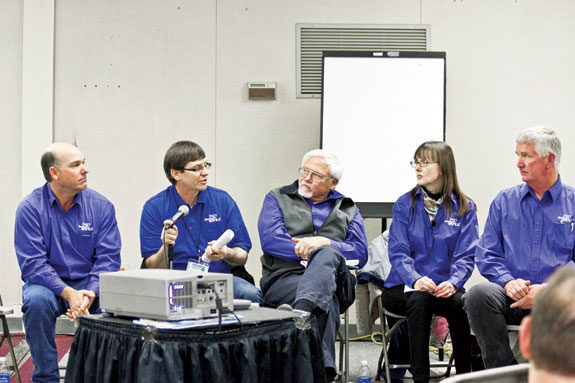Over the past decade the export market has become a viable portion of the U.S. dairy industry. A panel of dairy producer leaders shared their experience in learning more about this growing opportunity. California dairy producer and Dairy Management Inc. board member Jim Ahlem explained how the DMI business model has evolved over the years to increase the impact of each dollar invested by dairy producers.
It has moved away from advertising to focus on partnerships.
“For every dollar the checkoff invests, more than $6 are invested by our partners,” Ahlem reported.
The U.S. Dairy Export Council (USDEC), funded by the checkoff, leverages those dollars with funds from the USDA Foreign Agriculture Service and dues from its members. Margaret Speich with USDEC says the council’s goal is to increase the volume and value of U.S. dairy products on a global scale.
The latest trade data from December 2011 valued dairy exports at $4.8 billion, up 30 percent from the previous year. Exports in 2011 were equivalent to 13.3 percent of total U.S. milk solids. In 2010, that number was 12.8 percent and just 9.3 percent in 2009.
The largest category of products shipped is milk powder. Nearly 5 percent of the country’s total cheese production was exported last year. While it seems like a small percentage, Speich said that, as the world’s largest cheese producer, 5 percent still represents a lot of product.
The growing export market has helped absorb new milk production. Since 2004, about 60 percent of new milk went to exports.
Mexico has always been the No. 1 export market for the U.S., but in 2011 a milestone was reached. Export sales to this south-of-the-border country exceeded $1 billion, making it the U.S. dairy industry’s first billion-dollar export market.
Other top export markets include Southeast Asia, Canada, the Middle East, China, Japan and South Korea.
To explore one of those export markets, a group of dairy producers and DMI board members traveled to Japan. Jerry Messer from Richardton, North Dakota, said he was impressed at how vibrant the Japanese economy was compared to the U.S. at the time.
Most of the buyers there were concerned if the U.S. could be a consistent supplier. Fresh from the shortage caused by the devastating earthquake, tsunami and nuclear plant failure, the Japanese are looking to see who can best fulfill their needs.
For Sandy Stauffer of Nicholville, New York, one of the highlights of the trip was a cheese seminar sponsored by USDEC. A chef demonstrated a variety of ways to use American cheese to a crowd of 150 chefs and others who use cheese in their business.
The group also met with McDonald’s in Japan and learned it is beginning to work with the U.S. as a cheese supplier. However, the company said it needs to be sure its specifications are met, as well as have the guarantee the U.S. will be a consistent supplier.
Overall, it was a great opportunity for Brad Scott of Moreno Valley, California. He enjoyed being able to tell his own story to buyers in Japan.
Ahlem said most markets are looking for companies that will do just what this group of producers did – go into the market and ask the consumer what they want. PD
PHOTO:
TOP RIGHT: Serving on the panel at the World Ag Expo dairy export seminar were, left to right, Brad Scott, Jerry Messer, Sandy Stauffer, Margaret Speich and Jim Ahlem. Photo by PD Staff.
Expo seminar summaries
For the first time ever at World Ag Expo, Progressive Dairyman presented nine dairy-specific seminars. Prominent experts from across the U.S. addressed issues at the forefront of today’s dairy industry.

Karen Lee
Midwest Editor
karen@progressivedairy.com




